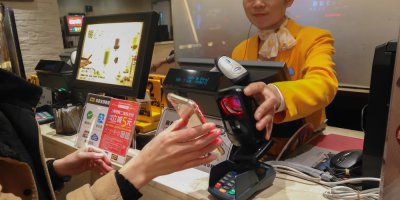
India’s road to becoming a cashless economy. (Photo by INDRANIL MUKHERJEE / AFP)
India’s road to becoming a cashless economy
- India is the country most in favor of a cashless society as 79% of Indians believe going cashless would have a positive impact on their country
- The pandemic has also put the spotlight back on the much-required collaboration among banks, financial institutions, and fintech to accelerate their digital journeys
- With the majority of transactions in India still cash-reliant, ‘Cashless India’ is still a distant dream
The earliest issuers of coins in the world are the Ancient Indians along with Chinese and Lydians from the Middle East. The first Indian coins were minted in the 6th Century BC, which is close to 3,000 years ago. Over the course of the millennia that have transpired since currency first came into use, the way Indians use money has undergone many transformations. A year of demonetization has shown how there has been a push towards a digital economy, but the love for cash refuses to fade and India’s cashless economy has yet to be fully realized.
MoneyTransfers.com analyzed the latest data from YouGov, to discover which countries in the world would most be in favor of a cashless society and found that India is the country most in favor of a cashless society as 79% of Indians believe going cashless would have a positive impact on their country. Malaysia (65%), UAE (63%), and Indonesia (63%) are among the other countries where over 60% of citizens would welcome their respective countries transitioning to just electronic payments. Interestingly, just 24% of Americans think going entirely cash-free would be a good thing for their country
India’s cashless revolution
If anything, the Covid-19 pandemic fueled a massive shift towards digital transactions in India — in tune with the prime minister’s vision of a Digital India. The vision got a big boost in the field of monetary transactions with the government’s demonetization move four years ago. Since then, there has been a marked increase in tools and solutions available in the e-payments sectors. The Indian consumer has the choice of e-wallets, United Payments Interface (UPI) systems, Unstructured Supplementary Service Data (USSD) services, and more, to transact financially online.
In fact, according to the National Payments Corporation of India (NPCI) data, payments on UPI in June 2020 hit an all-time high of 1.34 billion in terms of volume with transactions worth nearly Rs 2.62 lakh crore. MobiKwik, an online UPI application acquired around six million, new users, during the lockdown in April and May.
India is a mobile-first country, with hundreds of thousands of new users getting access to the internet each month. Currently estimated at 574 million, the number of monthly active internet users has grown 24% over that of 2019, indicating an overall penetration of 41% last year., according to the ICUBETM report. This permits banks to provide net-banking and mobile-banking services to customers.
After demonetization, even traditional banks had begun to incentivize customers to make payments digitally from their own bank accounts. As the natural step forward from here, other players have begun to promote cashless transactions for individuals and businesses alike.
Truth be told, India undoubtedly has the most advanced real-time payments system globally, and pre-pandemic numbers reflect the exponential growth. Findings from ACI’s global report, “Prime Time for Real-Time,” indicate that real-time payments in India will grow at 23.4 percent annually for the next five years as it seeks to lead the world in overall real-time payments volumes. At the same time, transaction volume is set to grow from 15.3 billion (present-day) to 52.8 billion.
With a combination of centrally driven initiatives, emerging payment instruments such as UPI, prepaid cards, NCMC mobility cards, BharatQR code, FASTag, and more, consumers are looking to adopt convenient alternatives for paying digitally. Although consumer spending across industries such as travel, fuel, retail, and entertainment took a hit in the last few months, a more precautionary lifestyle – encouraged by the government’s call to stay indoors and seek a more “digital” way of life – led many first-timers and novice internet users to embrace digital payments, including for utility bill payments, OTT, mobile recharge, grocery, pharmacy, and other essentials.
Fintech to the rescue
Reports are indicating that these days, a lot of the fintech players are working with neighborhood grocery stores, where merchants can send an SMS with a UPI payment link to customers, who can opt for deliveries with the added flexibility to pay for their purchases from the comfort of their homes.
The recent announcement of WhatsApp Pay collaboration with Jio has the potential to revolutionize the payments space as purchasing through WhatsApp chat will be simple and a key driver for customers to make in-app transactions. Payment innovations, alliances, and partnerships like these will enable the larger ecosystem while helping to respond to new challenges we face.
READ MORE
- Ethical AI: The renewed importance of safeguarding data and customer privacy in Generative AI applications
- How Japan balances AI-driven opportunities with cybersecurity needs
- Deploying SASE: Benchmarking your approach
- Insurance everywhere all at once: the digital transformation of the APAC insurance industry
- Google parent Alphabet eyes HubSpot: A potential acquisition shaping the future of CRM


